

















The Ramsden School for Boys

This
is
our
tribute
to
a
former
local
school.
‘Ramsden
Boys’,
at
one
time
was
the
largest
secondary/comprehensive
state
school
in
the
Orpington District and for over a decade over 1200 boys were attending the school each academic year.
After
the
2nd
World
War
there
was
an
urgent
need
for
housing.
Orpington
had
already
been
expanding
at
pace
in
the
1920s
and
1930s
and
the
war
years
only
interrupted
an
existing
huge
wave
of
new
local
authority
and
private
housing
developments
that
were
to
continue
into
the
1950s
and
1960s.
Priority
for
the
Orpington
Urban
District
Council
(ODUC)
was
the
continual
development
of
local
or
‘Council
Housing’
for
all.
Many
estates
had
been
previously
built
in
the
district
but
one
of
the
biggest
was
to
be
the
‘Ramsden
Estate’.
Designed
in
the
very
early
1950s
the
estate
took
advantage
of
excess
farmland
becoming
available
to
the
council
in
the
south-eastern
area
of
the
town.
The
OUDC
town
planners
started
work
on
a
plan
to
gradually
develop
the
estate
in
phases.
The
first
phase
(Ramsden
Road,
Brow
Crescent,
Petten
Grove,
Dyke
Drive,
Tintagel
Road,
Westbrook
Drive,
Brow
Close
and
parts
of
Quilter
Road
and
Rye
Crescent)
was
in
place
by
the
early
1950s.
Ramsden
Primary,
Ramsden
Secondary
School
for
Girls
and
Ramsden
School
for
Boys
were
also
built
in
this
phase.
The
two
secondary
schools
were
designed
with
shared
playing
fields
which
formed
an
‘island
of
green’
surrounded
by
the
suburban
sprawl
of
the
private
and
council
built
residential
properties.
As
the
1960s
came,
more
housing
was
required
and
planned
by
the
OUDC.
As
the
LBB
took
over
the
OUDC,
plans
changed
from
building
more
houses
to
high
and
medium rise flats & maisonettes, mainly located in the middle and to the edge of the estate.
As
part
of
the
development
of
the
estate,
work
on
the
building
of
The
Ramsden
School
for
Boys
started
in
1956.
The
land
was
amongst
the
oldest
in
the
district
to
be
fully
developed
and
this
attracted
a
lot
of
archaeological
interest
at
the
time
and
it
wasn’t
long
before
Deneholes,
Iron
Age
and
Prehistoric
artefacts
were
being
found.
In
fact
an
iron
age
farmstead
was
found
under
the
land
being
developed for the school. Some of these are displayed in the Bromley Museum at the Priory in Orpington.
The ‘Ramsden Boys School’ opened in 1959.
The
school’s
‘catchment’
grew
with
the
thriving
occupancy
of
local
housing
and
other
developments
in
the
late
1950s
and
early
1960s.
The
school
quickly
needed
to
be
expanded
to
cater
for
the
demand
so
in
1962
a
Technology
and
Art
Block
was
built.
In
1974
the
school
expanded
again
and
a
large
annexe
was
built
to
cater
for
science,
humanities,
music
and
a
library
was
opened
for
the
autumn
term.
The
school
was
the
‘catchment
school’
for
the
local
council
estate
and
as
a
secondary
modern
and
then
comprehensive,
it
catered
for
all
children
of
all
abilities.
As
such
Ramsden
Boys
was
well
invested
in
and
boasted
purpose
built
technology
facilities
for
Craft,
Design
and
Technology.
There
was
a
language
laboratory,
music
rooms,
a
technical
drawing
studio,
a
building
studies
area,
motor
vehicle
studies
workshop.
The
school
had
a
suspended
wooden
floor
gymnasium,
a
large
sports
hall,
tennis
courts
and
plenty
of
playing
fields.
A
field
study
centre,
‘Ramfield’,
in
Glenavon,
South
Wales
was
purchased
in
the
early
1980s
and
1000s
of
pupils
enjoyed
many
weekends there.
From
the
1970s
through
to
the
early
1980s,
each
form
year
(1-5)
had
8
form
groups
of
approximately
30
pupils.
1200
pupils
were
taught
at
the
school
in
any
one
year
and
this
made
Ramsden
Boys
one
of
the
biggest
single
sex
schools
in
the
London
Borough
of
Bromley.
Now to take you back down memory lane.....


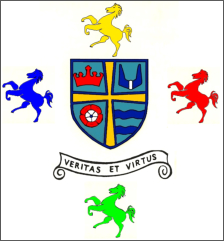
The Ramsden School for Boys Badge - A traditional heraldry shield divided into quarters.
Top Left - A Five pointed Crown- Respect, Honesty, Unity, Knowledge and Love
Top Right - A icon of a Rams Head and Horns, Ramsden was a big sheep farm that was the site of Ramsden Estate.
Bottom Left - Tudor Rose, This commemorated Queen Elizabeth the 1st Staying at Bark Hart House.
Bottom Right - The River Cray, fairly obvious.
The Shield is topped by the Kent Invicta. Coloured for each House; Blue for Danes, Green for Romans, Red for Saxons and
Yellow for Normans.
The scroll that contains the School Motto says 'Veritus Et Virtus' which latin for 'Truth and Virtue'.

1940: The ‘to be’ Site of the school and Ramsden Estate
1970c: Site of the school and Ramsden Estate
The
School
Badge
with
each
‘house’
represented
by
a
coloured
Invicta horse.


School Tie
Uniform
Black trousers, Black Blazer, white shirt, black shoes. The school tie and blazer badge were very unique.
Lessons
Ramsden Boys pupils had to haul an array of exercise books around with them. Here are some examples from the mid to late 1980s.








Contact Book and School Reports
Pupils
had
a
‘Contact
Book’
system
in
place
for
the
communication
between
Parents,
Teachers
and
Pupils.
The
contact
book
was
carried
by
pupils
at
all
times,
it
contained
their
contact
information,
their
lessons
schedule
and
two
pages
for
each
school
week
to
capture
homework
details
and
a
section
for
teachers
and
parents
to
exchange
messages.
Teachers
could
write
‘good’
or
‘bad’
notes
and details of detentions etc. Parents could write notes to teachers and reasons for absence etc.
‘Good
Notes’
were
given
as
praise
and
totted
up
each
week
by
a
form
tutor.
The
good
notes
could
end
up
with
an
end
of
term
letter
of
congratulation and a number of those could result in the pupil being given a school prize.
Like
most
secondary
schools,
Ramsden
Boys
had
term
based
progress
reporting
for
all
pupils.
A
‘school
report’
was
always
a
significant
event
for
a
pupil
as
it
gave
him
details
on
their
performance
and
a
rating
for
each
subject
he
was
studying.
Most
significantly it gave his parents the same information.......




1986 - School Report
1988 - School Report
1989 - School Report
1987 - School Report
1980’s Contact Book Cover
The
following
set
of
documents
are
letters
to
parents
congratulating
pupils
on
their
achievements
and
the
documents
used
at
annual
prize giving ceremonies.
Click on each item to see each description when the image ‘pops up’.



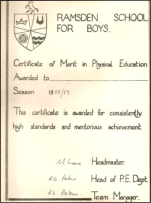

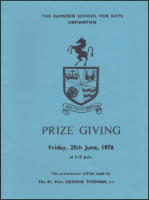






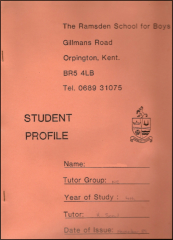
1989 - Student Profile
Click on each item to see each description when the image ‘pops up’.
Click on each item to see each description when the image ‘pops up’.
Sports
As
mentioned
above,
the
Boys
and
Girls
Secondary
schools
used
the
same
extensive
set
of
sports
fields.
The
Boys
school
had
a
wooden
sprung
floored
gymnasium,
purpose
built
‘Sports
Hall’,
Tennis
Courts.
Swimming
lessons
were
a
brisk
15
minute
walk
away
to
the Walnuts Leisure Centre.
Here are a collection of school teams.
Click on each item to see each description when the image ‘pops up’.



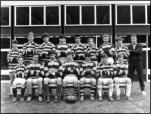






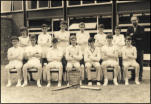

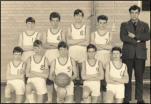


1980s Prefect Badge
Summer 1989
We
owe
Martin
Longman
a
huge
gratitude
of
thanks
and
to
his
son
Andrew
for
sending
these
pictures
of
the
School
in
it’s
last
days
of
being
the
‘Boys
School’..
I
am
sure
anyone
that
attended
the
school
will
appreciate
these
and
be
taken
back
to
their
school
days..
(it
did for me!).

























And finally.....
In
1988
it
was
announced
that
the
Boys
and
Girls
School
would
merge
to
become
‘The
Priory
School’.
This
was,
of
course,
hotly
contested.
The
rationale
by
the
LBB
was
that
catchment
pupil
numbers
were
down
and
on
the
decline.
The
view
of
some
was
that
the
LBB
wanted
to
cut
costs
and
also
sell
the
school
land
for
development
and
out
of
the
two
schools,
the
prospect
of
that
was
far
better
at
the
Gillmans
Road
site.
The
irony
of
this
is
that
within
5-10
years
of
the
schools
ultimate
demolition,
catchment
numbers
went
up
and the Priory, using the former Girl’s school buildings, had to significantly expand to accept the rising numbers....
The
School
closed
as
the
Boys
School
at
the
end
of
the
final
1989
term
but
wasn’t
demolished
until
1991.
The
last
year
(1990)
of
boys
who
would
be
‘5th
Year’
or
Year
11
in
the
new
Priory
School
wore
the
Ramsden
Boys
School
Uniform
and
were
based
in
the
old
school buildings. This meant approximately 150 pupils having full run on a school that was capable of 1200.
Thank you!
There
are
many
people
to
thank
for
the
creation
of
this
article
and
for
sending
their
images,
documents
and
memories
to
us.
In
no
particular
order:
Duncan
Stanton,
Martin
and
Andrew
Longman,
Tom
Yeeles,
Phil
Waller,
Alan
Treamer,
Tim
Fisher,
Ashley
Chastney
and others.
If
you
have
any
images,
documents
or
stories
please
visit
the
contact
us
page
and
get
in
touch
via
on-line
form
or
email
(
research@orpington-history.org
)
Teachers:
There
is
probably
a
memory
for
everyone
that
attended
the
school
reading
this
next
section..
We
have
tried
to
list
as
many
teachers
names as possible and what they ‘taught’... This list is not in any order or exhaustive.. If you can remember others please email them..
Mr
Lane
(Headmaster
and
Science
Teacher),
Mr
Seed
(English),
Mr
Pearce
(Deputy
Head
and
English
Chicken),
Mr
Churchill
(PE
and
English),
Mr
Cook
(French
and
Bell
Ringing!),
Mr
Lucas
(Music),
Mrs
Wood
(Science),
Mr
Hughes
(Head
of
Upper
School
and
Science),
Mr
Leicester
(Head
of
Year
and
Science),
Mr
Jones
(Head
of
Year
and
Art),
Mr
Hoyland
(Head
of
CDT),
Mr
Childs
(Art),
Mr
Long
(Music),
Mr
Reynolds
(Science
and
Caveman),
Mr
Pike
(Deputy
Head
and
Science),
Mr
Dean
(CDT),
Mr
Mansfield
Clarke
(Motor
Vehicle
Studies),
Mr
Probin
(Head
of
PE
and
Rugby
XV),
Mr
Dyall
(Humanities),
Mr
Robertson
(Head
of
Year
and
Maths),
Mr
Harding
(Head
of
year,
PE
and
English),
Mr
Manns
(English),
Mr
J
James
(Technical
Drawing),
Mr
Edwards
(History),
Mr
Coupland
(Head
of
Lower
School
and
PE),
Mr
Lang
(PE),
Mr
Wilkins
(PE),
Mr
Townend
(Science),
Miss
Williams
(Head
of
Year
and
English),
Mr
Decruz
(Music
and
French),
Miss
Matussi
(French)
Mr
Lancaster
(RE),
Mr
McQueen
(PE),
Mr
Hughes
(PE),
Mr
Griffiths
(PE),
Mr
Davies
(headmaster),
Mrs
Oakes
(English),
Miss
Collhoon
(English),
Mr
Lancastle
(Humanties),
Mrs
Lancastle
(Humanties),
Miss
Welch
(Art),
Mr
Clarke
(CDT),
Mr
Vass
(Science),
Mr
Bridges
(Maths),
Miss
Taylor
(English),
Mr
Thomas
(History),
Mr
Gosage,
Mr
Bannon
(English),
Mr
Hook,
Miss
Pearson
(French),
Mr
Walters
(French),
Mr
Steele
(CDT),
Mr
Tuelon
(Maths),
Mr
Hicks
(CDT),
Mr
Goreski
(Humanities),
Miss
Baines
(Maths),
Mrs
Mantura
(Maths),
Miss
Morgan
(German),
Mrs
Liddle
(Maths),
Miss
Duggleby
(French), Mr Humphries (Humanities) Miss Miller (English) Mr Eaglestone (Headmaster), Mr Wooding (Headmaster), Mr. Rankin (R.I.),
Mr. Earl (T.D.)
When
the
school
had
8
forms
per
year
there
were
7
‘sets’
for
core
education
(Maths,
Sciences,
Languages)
and
any
GCE/GCSE
subjects
lessons.
The
sets
were
labelled
R
A
M
S
D
E
N
with
the
first
three
being
the
top
sets,
S
and
D
being
the
middle
and
E
and
N
being the lower.
For lessons in non core lessons (Games, PE, Art, CDT, Humanities etc) the pupils would study in their House groups.





Click on each item to see each description when the image ‘pops up’.
School
Badge
in
Danes
House
Colours


Lessons
There were a number of subjects to learn at Ramsden Boys and most pupils got to experience the majority of what was on offer.
Click
on
the
Pathe
image
to
see
‘Schoolboys
at
Ramsden
Secondary
Modern
School
make
an
infusion
pump
to
help
people
with
kidney
problems.’
This is from 1966!
Ramfield was the school’s field study and
outdoor pursuit centre in South Wales. It is
situated in the valley town of Blaenavon just
outside Pontypool and most of the building
dates back to the 1850's and was until the
1950's the town's infant school. Together with
the adjacent junior school and the church of St Peters, the centre was very much
the nucleus of a thriving community of iron workers and then coal miners.
The Ramsden Boys school bought the site in the early 1980s and refitted it. Every
boy was offered the chance to go and enjoy outdoor activities with fellow House
members. This was also a chance to see teaching staff let their hair down a bit!
Ramfield carries on and is owned by the Priory School.



